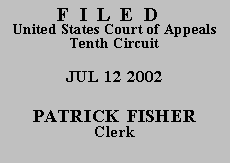

| DAVID B. ISHAM,
vs.
MIKE MULLINS, Warden |
|
After being placed in the Pre-Parole Conditional Supervision Program ("PPCS") in May 1996, Mr. Isham was not at his residence when his parole officer checked in on him. He was arrested in Ponca City, Oklahoma for public intoxication and later pleaded guilty to escape from custody, Okla. Stat. Ann. tit. 21, § 443(b), and was sentenced to two years imprisonment on February 14, 1997. Because Mr. Isham did not seek to withdraw his guilty plea or seek a direct appeal to the Oklahoma Court of Criminal Appeals ("OCCA"), his conviction became final ten days later on February 24, 1997. Rule 4.2(A), Rules of the Oklahoma Court of Criminal Appeals. On October 21, 1999, Mr. Isham filed an application for state post-conviction relief, the denial of which was affirmed by the OCCA on March 29, 2001. This petition was filed on May 21, 2001.
28 U.S.C. § 2244(d) establishes a one-year statute of limitations for filing an application for a writ of habeas corpus by a person in state custody. The limitation period runs from the latest of "the date on which the judgement became final by the conclusion of direct review or the expiration of the time for seeking such review," or "the date on which the constitutional right asserted was initially recognized by the Supreme Court, if the right has been newly recognized by the Supreme Court and made retroactively applicable to cases on collateral review." 28 U.S.C. § 2244(d)(1)(A),(C). However, "[t]he time during which a properly filed application for State post-conviction or other collateral review . . . is pending shall not be counted toward any period of limitation . . . ." 28 U.S.C. § 2244(d)(2).
As noted above, Mr. Isham's conviction became final on February 24, 1997. Therefore, under § 2244(d)(1), he had until February 23, 1998 to file his federal petition. Mr. Isham's state post-conviction actions (beginning October 21, 1999 with his application for state post-conviction relief) cannot toll the period of limitation because they occurred subsequent to the February 23, 1998 date on which his habeas petition was due.
Mr. Isham argues that his petition is timely under § 2244(d)(1)(C) because of the United States Supreme Court's decision in Young v. Harper, 520 U.S. 143 (1997), extending due process protections to preparolees, decided on March 18, 1997. Quite apart from the issue of whether Young v. Harper meets the tolling criteria under § 2244(d)(1)(C), Mr. Isham's federal petition is still time barred because that petition was filed more than a year after the Young decision. Equitable tolling is appropriate when a prisoner is actually innocent. Gibson v. Klinger, 232 F.3d 799, 808 (10th Cir. 2000). Mr. Isham cannot demonstrate that he is actually innocent, i.e. he was imprisoned for conduct not prohibited by law, on the strength of Young v. Harper, 520 U.S. at 152. While Young v. Harper, extended certain due process protections to preparolees in connection with preparole revocation, it simply did not negate Oklahoma law that preparolees may be prosecuted for escape when they cannot be located within a twenty-four hour period. See Okla. Stat. Ann. tit. 21, § 443(B) & (C) (1996).
We DENY the COA and DISMISS the appeal. We also DENY Mr. Isham's IFP motion as MOOT as the district court granted IFP.
Entered for the Court
Paul J. Kelly, Jr.
Circuit Judge
*. This order and judgment is not binding precedent, except under the doctrines of law of the case, res judicata, and collateral estoppel. This court generally disfavors the citation of orders and judgments; nevertheless, an order and judgment may be cited under the terms and conditions of 10th Cir. R. 36.3.
**. After examining the briefs and the appellate record, this three-judge panel has determined unanimously that oral argument would not be of material assistance in the determination of this appeal. See Fed. R. App. P. 34(a); 10th Cir. R. 34.1(G). The cause is therefore ordered submitted without oral argument.